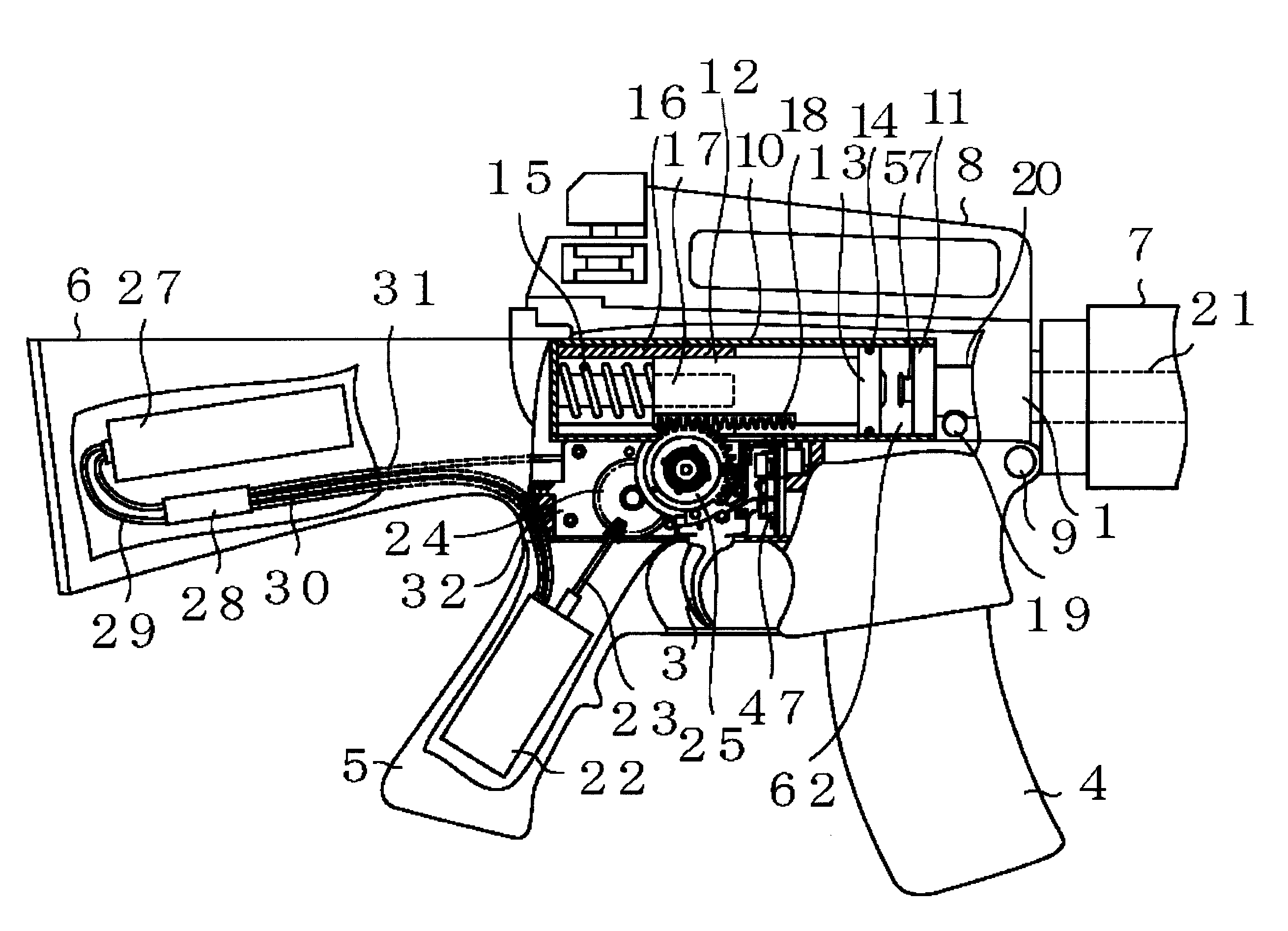Air Gun and Firing Stop Control Method
a technology of air gun and control method, which is applied in the field of electronic control of air guns, can solve the problems of inability to control how many times the gun was shot, defective operation, and easy defective operation due to burnt contacts or incomplete contacts, so as to prevent degradation of the spring effect of the spring, improve the reliability of the mechanical mechanism of the gun, and facilitate the inside of the gun
- Summary
- Abstract
- Description
- Claims
- Application Information
AI Technical Summary
Benefits of technology
Problems solved by technology
Method used
Image
Examples
first embodiment
of Control
[0078] Next, control flowcharts will be used to explain the bullet shooting control in detail.
[0079]FIG. 9 shows a first embodiment of control, and is a flowchart showing control of the single-shot mode operation.
[0080] First, control is started in step 100, and in step 101 a check is performed to determine whether the trigger switch 37 has been pressed. When the trigger switch 37 has not been pressed, a watchdog timer WDT is cleared in step 102, and operation returns to step 101.
[0081] When the microcomputer 49 is operating properly, this watchdog timer WDT is periodically reset in order that an error signal is not output, however, when the microcomputer 49 is not operating properly, the watchdog timer WDT is no longer reset periodically, but outputs an error signal and stops operation by causing a safety apparatus to function, etc. The timer value of the watchdog timer WDT is set to 1000 ms for example when the power to the microcomputer 49 is initially turned ON. The...
second embodiment
of Control
[0094]FIG. 11 shows a second embodiment of control, and is a flowchart of the control for the repeating mode operation.
[0095] First, control is started in step 120, and in step 121 a check is performed to determine whether the trigger switch 37 is pressed. When the trigger switch 37 is not being pressed, then in step 122 a watchdog timer WDT is cleared and operation returns to step 121.
[0096] In step 121, when it is detected that the trigger switch 37 is being pressed, then in step 123 a check is performed to determine whether there are bullets 19 in the magazine 4. This check is executed by inputting a signal from the bullet-detection switch 41 to the microcomputer 49 and checking whether the signal is ON or OFF. When there are bullets 19 in the magazine 4, the pressure member 42 for the bullet-detection switch pushes the bullet-detection switch 41 upward so that the switch is OFF.
[0097] In step 123 when it is detected that there are no bullets 19 in the magazine 4, op...
third embodiment
of Control
[0107]FIG. 12 shows a third embodiment of control, and is a flowchart for N-repeating mode control that is performed when performing the repeating mode operation N times. N can be any arbitrary positive integer 2 or greater. The inventors manufactured a gun with N as 3, however it is not limited to this.
[0108] First, control is started in step 140, and in step 141 a check is performed to determine whether the trigger switch 37 is being pressed. When the trigger switch 37 is not being pressed, then in step 122, the watchdog timer WDT is cleared and operation returns to step 121.
[0109] In step 141, when it is detected that the trigger switch 37 is being pressed, then in step 143 a check is performed to determine whether there are bullets 19 in the magazine 4. This check is executed by inputting a signal from the bullet-detection switch 41 to the microcomputer 49, and checking whether this signal is ON or OFF. When there are bullets 19 in the magazine 4, the pressure member...
PUM
 Login to View More
Login to View More Abstract
Description
Claims
Application Information
 Login to View More
Login to View More - R&D
- Intellectual Property
- Life Sciences
- Materials
- Tech Scout
- Unparalleled Data Quality
- Higher Quality Content
- 60% Fewer Hallucinations
Browse by: Latest US Patents, China's latest patents, Technical Efficacy Thesaurus, Application Domain, Technology Topic, Popular Technical Reports.
© 2025 PatSnap. All rights reserved.Legal|Privacy policy|Modern Slavery Act Transparency Statement|Sitemap|About US| Contact US: help@patsnap.com



